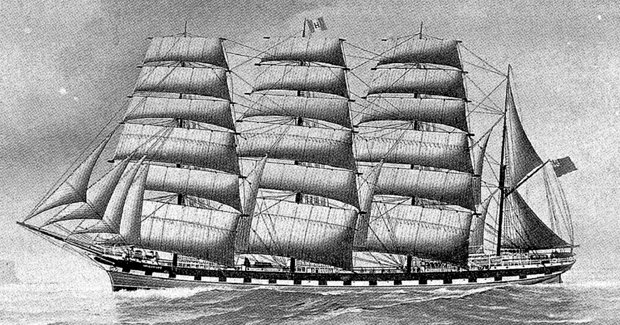On this day: Australia’s last convict ship docks

It’s a warm summer’s day on 9 January 1868 in Fremantle, Western Australia, and the last convict ship to transport prisoners to Australia is just coming in to port.
Upon seeing Australia for the first time, the prisoners no doubt feel a frisson of excitement mingled with a little fear, despite their sentences – compared to the gallows, Australia isn’t looking too bad.
It has been a relatively uneventful voyage – only one convict has died in the 89 days the ship has been at sea – but an unusual one; due to the reasonably high number of literate convicts from the complement of political prisoners from the Fenian Rising the previous year, the voyage even had its own newspaper: The Wild Goose, of which all seven handwritten issues survive in the State Library of New South Wales.
Babette Smith, historian and author of Australia’s Birthstain: the startling legacy of the convict era, says that transportation wasn’t as bad as its legacy decries. “Most of the prisoners got access to medical care and to meat,” she says. “And their children were often markedly taller and stronger.”
Some crimes were even carefully premeditated to warrant transportation with a lenient sentence as an escape from poverty in Britain, or to join family members.
Hougoumont – the last convict ship
The ship itself was no stranger to penal transportation; it was originally owned by Duncan Dunbar, who between 1840 and 1868 provided nearly a third of the ships that transported convicts. Under the direction of Luscombe of London, it set off from the Sheerness, on the Isle of Sheppey in the Thames Estuary, on the 30 September 1867, sailed along the south coast of Britain to Portland in Dorset to pick up more convicts, and finally departed Portsmouth on the 12 October, with 280 convicts and 108 passengers, helmed by William Cozens.
The complement of convicts included 62 Fenians, including 17 from the military, a contingent which contravened an agreement between the United Kingdom and Western Australia, leading to a brief panic in Fremantle. The inclusion of military Fenians also flouted the UK’s unwritten policy not to transport military prisoners.
Due to the high literacy rate amongst the prisoners, the voyage produced a number of diaries and accounts, notably those of Denis Cashman and Thomas McCarthy Fennell, and John Boyle O’Reilly’s letters.
This final complement of convicts signalled the end of a significant period in Australian history. Between 1788 and 1868, more than 165,000 convicts were transported to Australia, of which 10,000 were sent to Western Australia.
Australia’s convict legacy
Now, it is estimated that two million Britons and four million Australians have convict ancestors.
Without convict labour, the first arriving with the First Fleet in 1788, Australia might have initially struggled as a British colony, especially after 1810, when convict labour was increasingly used to develop the colonial infrastructure – roads, causeways, bridges, courthouses and hospitals.
Babette says “the expectation developed very early on that [Australia] provided a better opportunity for poor people.” By 1868, transportation had been campaigned against in Eastern Australia, originating some of the brutal legends about convict history, but in WA it was a case of brushing it under the carpet. “For Western Australia, the whole period was best forgotten.”
By the time penal transportation ended, Australia had grown to a population of more than 1 million – compared to just 30,000 in 1821 – and it was finally large enough to be autonomous, to sustain itself and grow.
And while the shroud of convict transportation has hung over Australia’s shoulders as somewhat of a negative stereotype, there’s no doubt it wouldn’t be the country it is today without them.

